Callable Bond

Key Highlights
-
A Callable Bond is a bond that provides the issuer (not the investor) with the option of repaying the bond in advance of its maturity date.
-
Key features includes call date, call price, coupon rate and call premium.
What is a Callable Bond?
A Callable Bond is a bond that provides the issuer (not the investor) with the option of repaying the bond in advance of its maturity date. This option provides the issuer with the ability to "call back" or retire the bond after a designated call date, often at a specified call price.
Why are Callable Bonds Issued?
Callable bonds are useful for issuers as they can refinance at lower rates of interest. For instance:
- Suppose a company issues a bond at 8% and the interest rate falls to 6%. It can call the existing bonds and issue new bonds at the lower rate, saving on borrowing costs.
Key Features
1. Call Date: The first date when the bond is callable (e.g., 5 years from issue).
2. Call Price: The amount at which the bond will be repaid if it is called—typically a little more than face value to reward investors.
3. Coupon Rate: Callable bonds tend to have a higher interest rate than non-callable bonds to entice investors (because of increased risk).
4. Call Premium: The additional sum paid above face value if the bond is called prematurely.
Types of Callable Bonds
1. European Callable: May be called only on a particular date.
2. American Callable: May be called at any time after a specified date.
3. Make-Whole Callable: Allows for prepayment by paying a premium equal to the net present value of future payments.
Example
A firm issues a 10-year bond at a coupon rate of 7%, with an option to call after 5 years. The firm can call the bond if interest rates decrease to 5% in year 5 and issue new bonds at a reduced rate, thus saving money.
Advantages and Disadvantages
For Issuers
Pros:
- Flexibility to refinance at lower rates
- Reduced long-term cost of interest
Cons:
- May have to pay a call premium
- Requires keeping liquidity for premature repayment
For Investors
Pros:
- Higher coupon rates compared to non-callable bonds
Cons:
- Reinvestment risk: Possibly have to reinvest at reduced rates if called bond
- Less upside if rates decline
Callable Bonds in India
Callable bonds in India are issued by:
-
Corporates: To keep interest costs flexible
-
Banks: Particularly Tier 2 Basel-regulated bonds, which have call options most of the times
-
Government and PSUs: Occasionally for infrastructure bonds of a long-term duration
The Reserve Bank of India (RBI) governs such issuances, particularly for banks and financial institutions.
